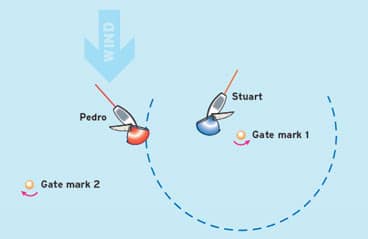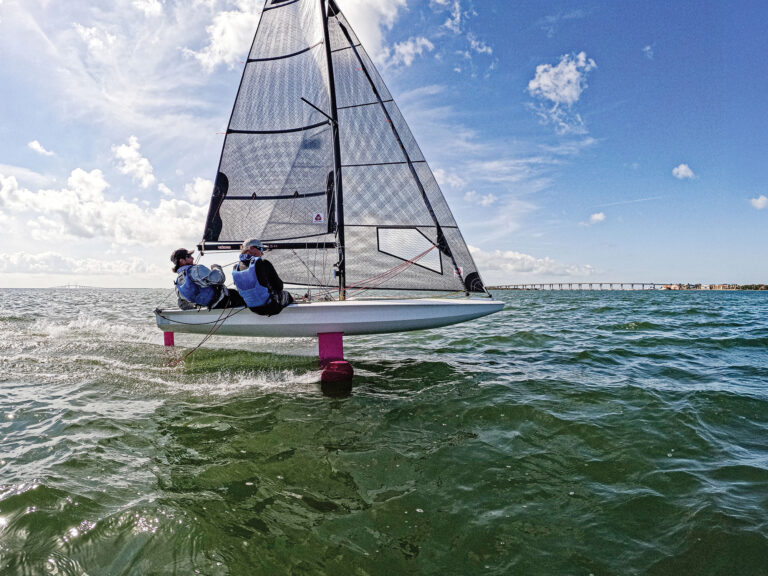
Rule 18 368
This is the fourth in a series of Rules columns explaining the new rules that apply at marks and obstructions. This month, I complete my discussion of Rule 18, the rule that applies at almost all marks. We look at luffing, late overlaps, tacking and jibing at marks.
Luffing a boat to the wrong side of a mark New Rule 18.2(b) and the new definition Mark-Room answer a question that competitors have been asking for years: When can an outside overlapped leeward boat with luffing rights luff the inside boat to the “wrong” side of the mark? Look at the first diagram. Top Dog and Rival are overlapped on port tack as they approach the leeward mark that is to be left to port. Earlier Top Dog had the lead, but Rival reeled her in and established a windward overlap. Therefore, Rule 17 does not apply to Top Dog and so she may luff Rival as high as she wishes, provided she complies with Rules 16.1 and 18. Before either of the boats reaches the zone, Rule 18 does not apply and Top Dog may luff Rival above the course to the mark. However, the moment that Top Dog reaches the zone, she is required by Rule 18.2(b) to give Rival ‘room to sail to the mark’ (see the first part of the definition Mark-Room). From that moment on, a luff by Top Dog forcing Rival above the direct course to the mark would break new Rule 18.2(b), even if, later, Top Dog bore away and let Rival sail to the mark. Under the old rules, there was no clearly defined moment at which Top Dog could no longer luff Rival to the wrong side of the mark.
Late overlaps New rule 18.2(e), like the rule it replaces (old Rule 18.2(e)’s second sentence) covers late overlaps- i.e., overlaps that begin just before the outside boat is required to give mark-room. The new rule fixes three flaws in its predecessor.
The old rule exempted an outside boat from the requirement to give room at a mark if she was unable to do so when the overlap began. The new rule exempts an outside boat from the requirement to give mark-room if, from the time the overlap began, she has been unable to give it. The new rule’s criterion is fairer to the inside boat. It will frequently be the case that a boat is unable to give mark-room at the instant that an overlap begins, but she will be able to do so a short time later. If Rule 18.2 requires an outside boat to give mark-room, she should do so if she can, and that is what new Rule 18.2(e) requires.
New Rule 18.2(e) only applies to inside overlaps. Here’s why this new condition was added. Suppose a boat established an outside overlap very close to another boat and then claimed that, because she was very close to the other boat, she was unable to give the other mark-room. That would not be fair to the inside boat.
New Rule 18.2(e) only applies to overlaps established from clear astern. This condition was added so that a boat that tacked into an outside overlap could not deny mark-room to the inside boat, as in the following example. At a windward mark to be left to starboard, Stan is close-hauled on starboard tack in the zone. Pam tacks into a lee bow position very close to leeward of Stan, and then Rule 18.2(a) applies and entitles Stan to room to tack (see the definition Mark-Room). If we did not limit Rule 18.2(e)’s application to overlaps established from clear astern, then Pam could claim that from the time the overlap began (when she turned past head to wind) she was so close to Stan that she was unable to give him room to tack.

****| |If Interloper tried this move today, she would break Rule 10.3(a), but last year she would have broken no rule.|
Tacking at a mark New Rule 18.3, Tacking when Approaching a Mark, differs from its predecessor, old Rule 18.3, in four respects. These are described below. None are major changes, and they will rarely affect most fleet racers.
• The words “completes a tack in the two-length zone” have been replaced by “changes tack, and as a result is subject to rule 13 in the zone.” This was done to eliminate a problem with old Rule 18.3. The second diagram illustrates a situation in which the problem occurs. In moderate winds and smooth seas, two keel boats on opposite tacks are approaching a windward mark to be left to port. Steadfast is fetching the mark on starboard tack. Interloper, approaching on port tack, luffs and turns past head to wind. After she passes head to wind she is on starboard tack. She does not immediately complete her tack by bearing off to a close-hauled starboard tack course. Instead she ‘shoots’ to windward on a course above close-hauled. If we had retained old Rule 18.3’s wording, then Rule 18.3 would not apply while Interloper was ‘shooting’ to windward and Steadfast would have been required by Rule 18.2(a) to give Interloper mark-room, even if that required Steadfast to luff above close-hauled. This tactic could have been used last year by port-tack boats to avoid the requirements of Rule 18.3. Because of the change of wording, Interloper would break new Rule 18.3 if she used that tactic today.
/sites/all/files/_images/201005/124-Beth_and_Ajay_overlap.jpg

****| |If Beth elects to overlap Ajay to leeward, she must initially give him room to keep clear|
By italicizing “fetching” and adding a new definition Fetching, we have clarified the meaning of the term. This was necessary because different dictionaries give different nautical meanings for the verb “fetch.”
The words “on the required side” have been added in new Rule 18.3(a). These were added to correct a small error in old Rule 18.3(a). To see the error, consider this situation. Approaching a windward mark to be left to port, suppose that the tacking boat completes her tack directly in front of a starboard-tack boat that was fetching the mark. The boat that had been fetching then bears off to avoid contact and, as a result, is no longer able to fetch the mark. That boat is not “prevented from passing the mark.” She is only “prevented from passing the mark on the required side.”
The words “in which case rule 15 does not apply” no longer appear in Rule 18.3(b). This will result in a slight game change in the situation shown in the third diagram. In this example, Beth was fetching the mark on starboard. Ajay made a bad tack from port to starboard and slowed down right in Beth’s path. Beth chose to bear off and establish an inside overlap to leeward of Ajay while he was still sailing to the mark. As a result of her decision to bear off, Beth becomes right-of-way boat after the overlap begins. Under new Rule 18.3(b), Beth must now comply with Rule 15 by initially giving Ajay room to keep clear after the overlap begins. Last year Rule 15 would not have applied.
Jibing at a mark Old Rule 18.4 is very similar to its equivalent in the new rules, new Rule 18.4. There are two differences between the old and the new versions of this rule.
The new rule only applies at a mark and no longer applies at an obstruction that is not a mark. This rule is in the rulebook for reasons of safety. We did not think it was needed at an obstruction that is not a mark.

****| |Because of a change in new Rule 18.4, Stuart can make a big gain on Pedro at this gate by sailing past Gate Mark 1 and forcing Pedro to jibe.|
Rule 18.4 no longer applies a gate mark. This will actually create an interesting game change that you may be able to use to your advantage. Consider the situation shown in the last diagram. Stuart, on starboard tack, is converging with Pedro, who is on port. Both boats intend to round Gate Mark 1 to port. Under the old rules, Rule 18.4 would have required Stuart to jibe at the point where he would have jibed if Pedro had not been on the scene and this could have prevented Stuart from using Rule 10 to force Pedro to jibe away from the mark. Now, Rule 18.4 does not apply because the mark is a gate mark. Therefore, Stuart is not required to jibe at any particular time, and he can carry on farther and force Pedro to jibe away from the mark. Thus, Stuart can now force Pedro either to jibe twice to round the favored gate mark or to round the less favored gate mark. Either way, Stuart can now make a nice gain by forcing Pedro to jibe.
Stay tuned for a discussion of new Rules 19 and 20 in upcoming issues.
E-mail for Dick Rose may be sent to [email protected].









